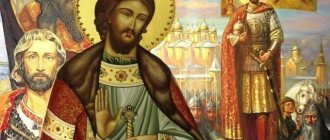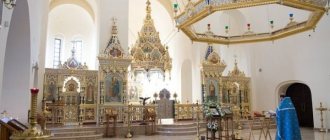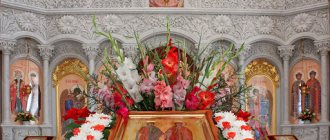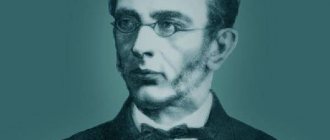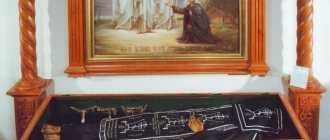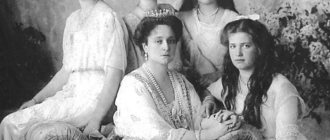Life of Alexander Nevsky: summary
On May 13, 1221, a second child was born into the family of Grand Duke Yaroslav Vsevolodovich, who was named Alexander. According to some sources, the date of birth is May 30, 1220. Fate prepared for the young prince a bright and worthy life , forever inscribed in the history and memory of people.
The boy was deprived of his childhood early - already at the age of 9, he, together with his older brother, sat on the princely throne of Veliky Novgorod. And three years later, after the death of Fyodor Yaroslavovich, he remained his sole ruler , since his father left after some time to sit at the head of Kiev.
In 1239 he married the Polotsk princess, who gave him five children:
- Basil (1245−1271);
- Dmitry (1250−1294);
- Andrew (1255−1304);
- Daniel (1261-1303);
- Evdokia.
True believers will certainly be interested in an article about the birth, life and parents of Jesus Christ.
Military campaigns and battles
By the time of the reign of the noble prince, a rather difficult political situation had developed in the primordially Russian lands. In the east, the Mongol horde was gaining power and destroying everything in its path. In the west, another threat arose - the crusading knights, who also set out to conquer new territories with the blessing of the Pope. In addition, internecine wars between neighboring principalities for supreme power did not stop. All this had to be regulated by the young prince of Novgorod.
Alexander Yaroslavovich took part in military campaigns from a very early age. At first he accompanied the priest, then on his own as a renowned commander. Famous battles:
- July 15, 1240 - Battle of the Neva. It was thanks to her that the prince’s name went down in history with the name “Nevsky”. On the banks of the Neva River, the military leader, who was not yet 20 years old, stopped the invasion of the Swedes going to capture Pskov and Novgorod. But despite the brilliant victory and liberation from their enemies, the Novgorodians rebelled, and Alexander was forced to leave the city. However, a year later the city was captured by the Livonian Order, and the prince was again asked for help.
- April 5, 1242 - Battle of the ice on Lake Peipus, where the Livonian army was completely defeated. This battle was very important - a final truce was concluded with the order and completely got rid of the danger of its invasion of Rus'.
Stories about these events can be found not only in the Life of St. Alexander Nevsky, but also in Western chronicles .
Prince's political activities
The years of Alexander Yaroslavovich's reign can be divided into several periods:
- 1236−1240, 1241−1252, 1257−1259 - Prince of Novgorod;
- 1249−1263 - Grand Duke of Kyiv;
- 1252−1263 - Grand Duke of Vladimir.
During his reign, Alexander showed himself not only to be a brave warrior, but also a very bright and far-sighted politician. He realized that power could not be retained only through military action with Western colonialists. There was also an eastern threat. Here he was guided by completely opposite views .
He repeatedly visited the Horde with peace negotiations, which resulted in his accession to the throne in Kyiv in 1249, and his brother, whose name was Andrei, in Vladimir. True, in 1252 he had to take the Vladimir throne after the abdication of the ruling prince.
a similar policy throughout the years he spent in power. This raised many questions and rejection, since the majority did not understand and did not accept constant friendly visits to the Tatar-Mongols.
Nevertheless, it was precisely this line of behavior that was most effective for that time. Despite his obvious leadership talent and a number of won battles, the priority for the prince was the peaceful resolution of conflicts. It was for these reasons that he paid friendly visits to the Horde khans and made concessions to their demands. And although tribute still had to be paid, this helped save Rus' from ruinous raids.
Death of Alexander Nevsky
The prince died at a fairly young age - at 42 years old. Having gone to the Horde to resolve another controversial issue, Alexander became seriously ill and, returning to his homeland, never recovered from his illness. Before his death, which occurred on November 14, 1263, he managed to take a monastic vow under the name Alexy. Initially, the grave was located in the Vladimir Nativity Monastery, where he was buried.
Personality assessment in history
Who this prince is was briefly discussed above. He left an indelible mark on Russian history thanks to his personal qualities and character, which were unusual for his contemporaries. This also became the reason for the ambiguous attitude towards his actions and actions in subsequent centuries.
There are three different positions from which Alexander Yaroslavovich Nevsky is viewed:
- Church, according to which the clergy unconditionally recognize and praise the saint as an outstanding representative of his time, who made a huge contribution to the revival, development and formation of the Russian state.
- Eurasian, which focuses on the unprecedented relationship of the Grand Duke with the Tatar-Mongol horde, which contributed to the fusion of two such dissimilar cultures.
- Critical, whose followers do not recognize the merits of the commander and see only the negative sides of his rule. Its occurrence is associated with various versions of the description of the life of the saint and conflicting information, which prompted historians to think about the distortion of real facts and their exaggeration or downplaying. According to followers of this version, it was Nevsky’s reign that became the impetus for the further development and strengthening of the despotic power of future overlords.
Main characters
Main character:
- Alexander Nevsky is a great commander. Over the years, he ruled in Kyiv, Novgorod and Vladimir.
Minor:
- Prince Yaroslav Vsevolodovich - in different years ruled in Pereyaslavl, Kiev, Novgorod and Vladimir. Alexander's father;
- Batu - Mongol commander, khan;
- Andreyash - German king;
- Prince Andrei is the brother of Alexander Nevsky;
- Dmitry is the son of Alexander.
Canonization of a saint
During his reign, Alexander Nevsky was one of the patrons of the Orthodox Church. He never spared money on the construction and improvement of temples, decorating them with various utensils and literature. He also became the founder of the Orthodox diocese in the Muslim Horde.
The prince began to be revered as a saint immediately after his death by his contemporaries. In the Life there is evidence of a real miracle that occurred during the burial. Firstly, until the very moment of burial, the prince’s body did not undergo any changes. And, secondly, while the last parting words were being placed in his hand, he himself, as if alive, held it out and took the letter. This was regarded as a sign of the Lord’s veneration of his saint.
Later, a life of the pious prince was compiled, which was subjected to repeated revisions over the following centuries. In total there are about 20 versions of it.
The church officially canonized Alexander Nevsky in 1547 during the reign of Ivan the Terrible. At the same time, not only his human qualities were glorified, but also his military exploits in the name of his homeland.
All this time, the relics of the saint were at the place of his burial in the Vladimir monastery. And on the eve of the most significant and decisive battles, the commanders turned to them with prayer for help and protection in the future. At the same time, either the image of the saint himself appeared to them, or some miracle occurred, which was regarded as a sign of blessing and impending victory. All miracles were regularly recorded by chroniclers.
With the coming to power of Peter the Great, a new period began in the veneration of the saint. He considered himself the successor of the great military leader in the fight against the Western aggressor in the person of Sweden. And after a brilliant victory over the Swedes in 1723, he ordered the relics of the noble prince to be moved to the Alexander Nevsky Lavra, specially built for this purpose by order of the tsar in the new capital. The procession was supposed to arrive at the place by the beginning of autumn, but due to various delays on the way, this did not happen until October 1 in Shlisselburg. It was decided to leave the relics in the local church for a year.
The body of the saint was moved to St. Petersburg on August 30, 1724. Peter the Great himself personally took part in the ceremony and controlled the galley on which the remains were transported. It was this day that was established as the main day of remembrance of the saint.
Currently, the church celebrates the celebration of St. Alexander Nevsky several times a year:
- 23.05 (05.06);
- 30.08 (12.09);
- 23.11 (06.12).
In 2008, by voting, the noble prince was recognized as “the name of Russia,” and in 2021, with the blessing of Patriarch Kirill, he was named the official patron of the ground forces.
Currently, the icon of Alexander Nevsky is extremely popular among Orthodox believers and is treated with great reverence. In their prayers, the suffering turn to the saint with various requests for help, to give courage and to protect their Fatherland from enemies. This is the patron saint of all warriors; it is to him that mothers turn to when they are expecting their sons to leave the army.
Retelling very briefly
If you briefly read “The Life of Alexander Nevsky,” then in a few minutes you can understand the main meaning of the work. A brief retelling of the main events is presented below.
Alexander Nevsky grew up handsome, stately and strong. Because of the attractive appearance of the young men, others were interested in them. Noble people from different countries came to Russian soil to look at the young prince.
One day the Swedes wanted to conquer the Russian state. Before leaving, the prince instructed Pelgusius to stand guard. He noticed the passion-bearers Boris and Gleb in the distance. The man told the prince about this, and Alexander went against the enemy. So the enemy was defeated.
The next year, the Latins who came from the Western side attacked. Alexander destroyed the villages they had built. In the third year, the Livonian Germans attacked. The prince again defeated the enemy. Another battle took place on Lake Peipsi. And this time the Germans went under the ice. The Russian army won.
The commander goes home after meeting with the khan, but falls ill on the way. Before his death, he took monastic vows. Alexander's body was taken to Vladimir.
The image of Nevsky in art
One of the interesting facts is that the original image captured on canvas during the life of the Grand Duke has not survived. His image was collected from various sources and descriptions of the 13th century, which was reflected in literature, fine art and cinema. The most famous portrait of Nevsky was painted from the actor who played the role in the film of the same name by Sergei Eisenstein. It was also taken as a prototype for the order named after the famous commander.
In addition, streets and squares in many Russian cities were named in his honor, monuments were erected. Temples throughout the post-Soviet republics are dedicated to the blessed prince.
Despite such a contradictory characterization, the name of the saint rightfully took its place in the memory of descendants. And many have no doubt why it has survived centuries and become so famous.
Read also
Prince Alexander was the son of Grand Duke Yaroslav. He was powerful, intelligent and brave.
One day, the king of the Roman faith from the Midnight Country wanted to seize the prince's territory. Having learned about this, Alexander immediately went to his opponents with a small squad. The eldest, named Pelugius, Alexander was entrusted with naval guard. Prince Alexander went into battle and brought a blow to the king himself. The rest of the opponents rushed.
A year later, people from the Western country showed up again, and they built a small town on land that was foreign to them. Alexander immediately destroyed the city. He punished some of his opponents and spared some.
In the third year, Alexander went to German territory with a huge army. He liberated the city that had been taken earlier. The battle took place on Lake Peipsi. When the prince returned with victory, the population of the city majestically welcomed him at their walls.
In the Eastern country, at the same time, there was a powerful ruler. He sent people to the prince and ordered him to come to him in the Horde. Alexander went to King Batu. The second was angry with Andrei, the Suzdal prince, and his commander Nevruy devastated the Suzdal land. After this, Grand Duke Alexander restored cathedrals and cities.
Meanwhile, the king of the Eastern country forced the Christians to go with him on the road. Hearing this, Alexander arrived in the Horde to convince the king not to act in the way he wished. And he sent his own son Dmitry to Western states. He took the city of Yuryev and returned to Novgorod.
Rate the product: Votes: 292
Read a summary of the Life of Alexander Nevsky. Brief retelling. For a reader's diary, take 5-6 sentences


